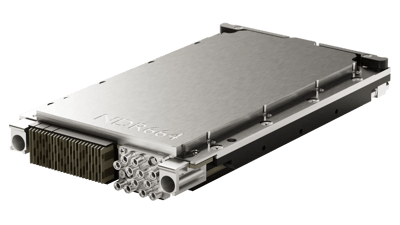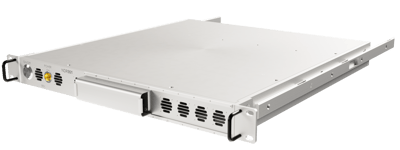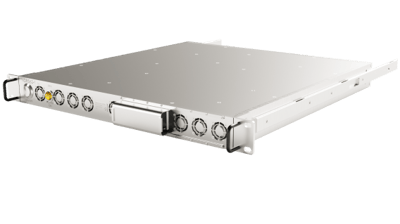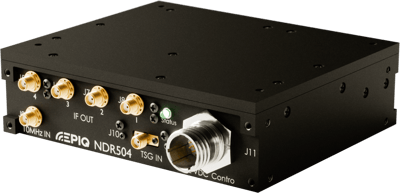PRiSM CBRS Interference Detection
Epiq Marketing
02/09/23
By Amy Devine
Citizens Broadband Radio Service (CBRS) is a 150 MHz wide broadcast band of the 3.5 GHz band in the United States. It allows multiple carriers to use the same frequency spectrum while granting priority to military, commercial satellite operators and Wireless Internet Service Providers (WISPs).
While essential and widespread, this kind of telecommunication leaves room for hiccups. In fact, a myriad of TDD-LTE CBRS network operators have voiced concern about interference since its launch.
Epiq's PRiSM PCI Scanner optimizes RF for individual or private use by granting detection and data insight to anyone, whether they're an RF engineer or not.
CBRS as a Service
Since its rollout, CRBS remains an essential service. Most smartphones and LTE devices manufactured in the last three years are natively compatible with networks that operate in the 3550 to 3700 MHz CBRS frequency range in the United States. This is because, in most ways, CBRS is identical to traditional LTE and uses the same backend LTE technology to operate.
Any CBRS-capable device with a public carrier SIM can connect to the private cellular wireless network and continue to access the MNO network services natively — as if it were connected to a public MNO cell tower. No other free-to-use spectrum can accomplish this today.
High noise on CBRS channels is often the cause of interference and, in most cases, that interference cannot be tracked down using a spectrum analyzer. This is where Epiq's PRiSM PCI Scanner comes in. PRiSM can inspect the upper LTE protocol layers that other spectrum analyzers simply cannot see.
CBRS Technical Details
CBRS operates within the range of 3550-3700 MHz, through 15 and 10 MHz channels. This is further broken down into 3GPP TD- LTE Band 48 for Priority Access License (PAL) and General Authorized Access (GAA) operation:
- 3GPP. This is the Third Generation Partnership Project. It's meant to bring together Standards Development Organizations (SDOs) around the globe to develop technical specs for 3rd generation of mobile, cellular telecoms and more. Think 5G and LTE, which we've discussed.
- TD-LTE. Time Division-Long Term Evolution, or wireless networking. Band 48 devices is another way of saying private LTE, which falls within 3.5 GHz frequency and is the go-to for telecommunications entities.
- PAL. Priority Access License operates up to 70 MHz over 8 channels available to license in a CBRS area.
- GAA. Unlicensed spectrum use can be accessed for free. CBRS already functions with this in mind.
This carrier aggregation is used to increase bandwidth for LTE systems and ensure backward compatibility for applicable systems for Intraband and Interband carrier combinations.

The Shared Spectrum Model
CBRS shared spectrum access is broken up into three bands that ensure all users receive the coverage they require. These bands of access are:
- Incumbents. This tier has the highest priority for CBRS spectrum access and includes groups who were utilizing frequencies in bands 42 and 43 before their reallocation.
- Priority Access License (PAL). This license allows the lease of 10 MHz channels for dedicated use.
- General Authorized Access (GAA). And the lowest tier, GAA, provides free public access to the CBRS spectrum.
Each of these tiers is subject to override by the tier above it.
Supporting this infrastructure are two important functions:
- Spectrum Access System (SAS). This functions as the centralized database of CBRS emitters (like eNBs) that communicate with UEs and towers on what functionality is required based on incumbents in the area. This is also known as a frequency coordinator.
- Environmental Sensing Capability (ESC). These sensors are there to detect incumbents as they begin to operate within a CBRS area. This is essential for mapping and resourcing your network.
Multiple Providers Can Use the Same Heavy Iron Installation
CBRS operates in the range of 3350 to 3700 MHz, as designated by the United States Federal Communications Commission (FCC). Quality CBRS is capable of allowing multiple providers to network and coexist without compromising technical performance, even with additional network layering for small cells.
Neural Host Networks
Neural host networking is third-party wholesale carriers leasing their cellular network to a customer directly. In CBRS, private entities use a cellular network for one or multiple mobile network operators (MNOs). Furthermore, Distributed Antenna Systems (DAS) are used to amplify and split wireless signals for increased coverage. But as bandwidth increases, so does the risk of a spottier connection.
In cases like this, PRiSM can improve compatibility, connection and data collection in a free-roaming environment. And when CRBS falters, PRiSM provides you with the details of the network — giving administrators the additional insight they need to improve connections and mitigate future threats. Plus, it scans all carriers and bands — not just the network associated with the host phone or tablet.
Private LTE Networks
MNOs are routed directly with local private networks. Meanwhile, dedicated radio equipment is used in the service area, extending the public MNO down into private LTE networks. PRiSM further provides network optimization opportunities, leading to opportune outcomes:
- Better CBRS handover. Client services operate at better efficiency for sustained coverage. Everyone wants things to operate well, and PRiSM ensures RF sensing and transceiving insight for those necessary improvements.
- Increased coverage for LTE, 5G and earlier-generation devices. Compatibility for multigenerational devices is essential for any service. PRiSM is designed to help administrators map coverage and move toward solutions.
- Happier customers. Epiq has built plenty of comprehensive solutions with firsthand knowledge and experience of how complicated RF can be. PRiSM, alongside the rest of our product lineup, provides admins with the solutions they need to improve the customer experience.
In short, PRiSM allows people to do their survey jobs with higher fidelity and less headache. This is true for technicians as much as it is for normal people, as well. Whether you're an RF expert or not, PRiSM makes surveying and detection easy on the CBRS.
The Benefits of CBRS for Mobile Network Operators (MNO) and End Users
CBRS allows providers to share one antenna and 150MHz in the 3.5 GHz spectrum, unlike traditional 4G LTE. This means that operating in an individual RF spectrum is not required. This provides many benefits to both the MNO and end users.
MNO:
- Lower potential infrastructure cost.
- Offloads indoor traffic from traditional 4G LTE towers.
- No change to existing EPC, since the modification is only to the RAN.
End Users:
- Ability to create private LTE networks.
- Enhanced indoor coverage.
- More options for mobile network access.
Any CBRS-capable device with a public carrier SIM card can connect to a private cellular wireless network and continue to access the MNO network services natively — all as if it were connected to a public MNO cell tower. No other free-to-use spectrum can accomplish this feat today.
Technicians are involved every step of the way, ensuring that signals run properly. With all of this detail, it can be easy to get lost in the noise. PRiSM is a handheld solution that allows anybody to identify disruptions and make adjustments as necessary.
Cell Phase and TDD-Configuration
The cell phase is the maximum absolute deviation in frame start timing between any pair of cells on the same frequency that have overlapping coverage areas. TDD configuration is often where network operators get stuck looking at the RF layer, but not taking into account upper layers like TDD-LTE, which can also cause interference.
SAS-CBSD Protocol Defined by WInnForum
WInnForum provides the guidelines for proper SAS-CBSD protocols, which are:
- Each CBSD and SAS must test its implementation against WInnForum's test specification.
- They must include a declaration on the package and any materials related to self-testing and comparable parameters.
- They must submit written statements to WInnForum summarizing testing for each feature.
- They must meet appropriate feature criteria.
Without WInnForum's standardization, CBRS would be more difficult to define. Products and features of emerging LTE and RF technology are benchmarked against these standards for technology enhancements and an ecosystem that regulates and certifies that technology operates as intended.
How PRiSM Operates with CBRS
Hiccups on a CBRS band usually occur when there's been a misconfiguration between providers, causing interference.
When these things happen, the technician who's in their truck and dispatched to solve the problem can take PRiSM out of their pocket, hook up to their phone and begin to do their job. With no additional software to install, you simply connect PRiSm to your device and open the browser to the IP address.
The technician can freely walk about a site and collect data on the CBRS band — whether that be an NFL stadium or another type of building. The SWaP (size, weight and power) of PRiSM allows for freedom of movement in all kinds of environments. With the press of a button, data can be downloaded and exported for a report or post-processing, which makes monitoring changes over time that much easier.
Alternatively, you could even leave a PRiSM unit in a location for some time, when a cell phone or laptop battery allows it. In doing that, it provides power measurements along with other network parameters. Epiq is currently in the process of adding more parameters, too — making it easier to identify interferences and, thus, enabling a faster time to resolution.
Learn more about PRiSM or contact us for more information at <info@epiqsolutions.com>.
SHARE
Tags
STAY INFORMED
Stay up to date with the latest Epiq news, product releases, and more.












.webp?length=400&name=Cyber-Radio-NDR585%20(3).webp)


















.webp?width=70&height=70&name=Vector%20(1).webp)


